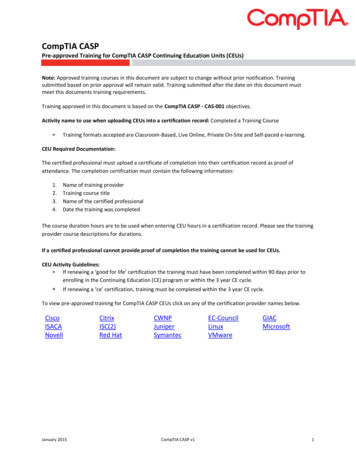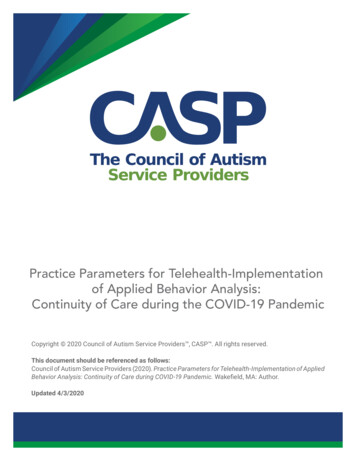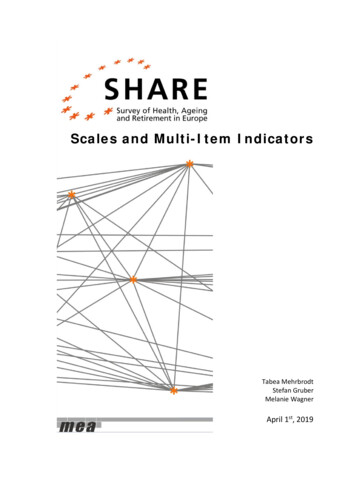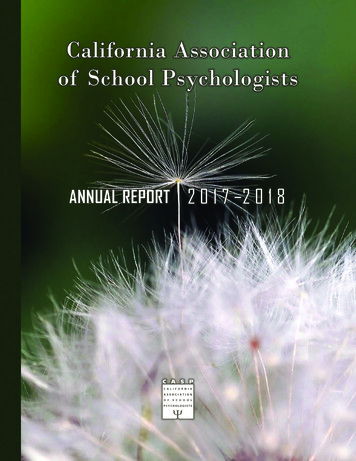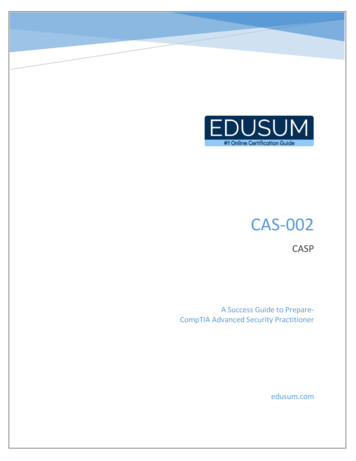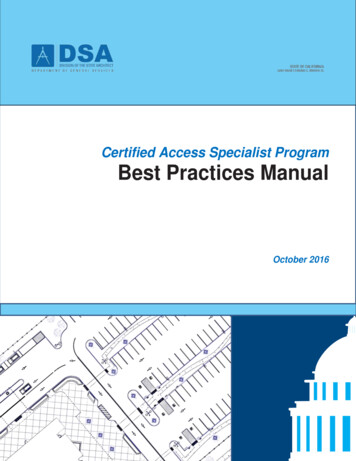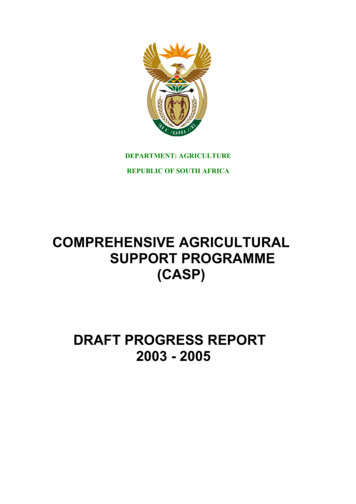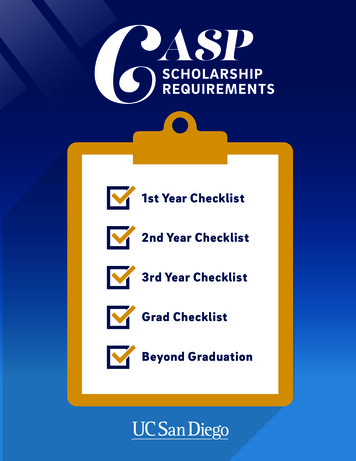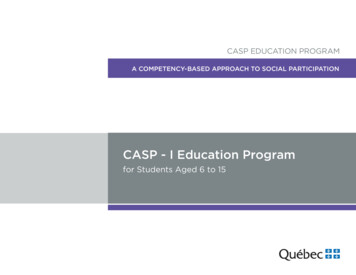
Transcription
CASP EDUCATION PROGRAMA COMPETENCY-BASED APPROACH TO SOCIAL PARTICIPATIONCASP - I Education Programfor Students Aged 6 to 15
This document was produced by the Ministère de l’Éducation et de l’Enseignement supérieur.Production and publicationDirection de l’adaptation scolaireSecteur de l’éducation préscolaire et de l’enseignement primaire et secondaireFor information, contact:Renseignements générauxMinistère de l’Éducation et de l’Enseignement supérieur1035, rue De La Chevrotière, 21e étageQuébec (Québec) G1R 5A5Telephone: 418-643-7095Toll-free: 1-866-747-6626Special contributionCaroline Drouin, special education consultantPierrette Jalbert, learning evaluation consultantAn electronic version of this document is available on the Ministère’s website at:education.gouv.qc.ca.Contribution Gouvernement du QuébecMinistère de l’Éducation et de l’Enseignement supérieur, 2019Caroline Germain, assistant director, Services éducatifs complémentaires et de l’adaptation scolaire,Commission scolaire de Saint-HyacintheISBN 978-2-550-85226-1 (PDF)ISBN 978-2-550-78330-5 (French, PDF)AcknowledgementsLegal Deposit – Bibliothèque et Archives nationales du Québec, 2019We would like to thank everyone who contributed directly or indirectly to the development of thiseducation program, especially the resource people in regional services (“SRSEs from the French sector)and the coordinator of the Centre of Excellence for the Physically, Intellectually, and Multi-Challenged,along with the many teachers who participated in the different stages of the production of this document.Title of original documentProgramme éducatif CAPS-I – Compétences axées sur la participation socialeEnglish translationDirection du soutien au réseau éducatif anglophone – Services linguistiques en anglaisMinistère de l’Éducation et de l’Enseignement supérieur
Message from the MinisterQuébec schools are inclusive; they foster the overall development of each individual student. It is therefore essential that young peoplewith intellectual disabilities aged 6 to 15 have access to an education and services adapted to their needs. The CASP-I Education Program:A Competency-Based Approach to Social Participation advocates an approach to learning that is in step with the realities of students’ livesbut also ensures they develop general competencies that will allow them to be active in community life to the best of their abilities.The CASP-I Education Program is the culmination of several years of work. The 2019 version of the program reflects the combined effortsof teachers, education consultants, researchers, regional support personnel and specialists, and a large number of education professionals.The constructive comments of these contributors have enriched the program, paving the way for its smooth implementation in Québecclassrooms, regardless of how services are organized.It is important that all members of the school team work together in a spirit of true collaboration. Ultimately, the objective is to establishthe necessary conditions, taking the needs and abilities of each student into account, to enable all students to pursue their learning anddevelop self-determined behaviours. Of course, none of this would be possible without the participation of parents, who play a key rolein their children’s educational process.Let us continue uniting our efforts to enable young people with intellectual disabilities to increase their ability to play an active rolein society.JEAN-FRANÇOIS ROBERGEMinister of Education and Higher Education
Avant-proposFormer au mieux tous les jeunes implique que les élèves ayant une déficiencepédagogique différenciée qui sera adaptée aux enfants et aux adolescents. Il tientintellectuelle occupent la place qui leur revient à l’école et tirent profit, au mêmelieu de référence indispensable pour l’ensemble du personnel scolaire qui travailletitre que les autres élèves, des grandes orientations éducatives découlant duauprès de ces élèves.Programme de formation de l’école québécoise.Le présent document constitue un renouvellement des Programmes d’étudesLe Programme éducatif CAPS-I Compétences axées sur la participation socialeadaptéss’adresse aux élèves âgés de 6 à 15 ans qui présentent une déficience intellectuelleprimaire (1996) et des Programmes d’études adaptés avec compétences transférablesmoyenne à sévère1 et qui ont été exemptés de l’application des dispositions relativesessentielles (PACTE) – Enseignement secondaire (1997). Il sera suivi duà la grille-matières, comme le prévoit l’article 23.2 du Régime pédagogique deProgramme éducatif CAPS-II Compétences axées sur la participation sociale, unl’éducation préscolaire, de l’enseignement primaire et de l’enseignement secondaire.programme à l’intention des élèves de 16 à 21 ans, conçu de façon à répondre auxCe programme tient compte des différentes politiques et stratégies ministérielles quibesoins particuliers de ces jeunes en vue de leur intégration sociale etvisent à bâtir un milieu scolaire et une société plus inclusifs et plus équitables. En ceprofessionnelle.sens, il met au premier plan les principes fondamentaux d’une école adaptée à seignementLe premier chapitre de ce document expose le contexte ayant conduit auses élèves2. À l’instar du Programme de formation de l’école québécoise pour lerenouvellement des programmes, la triple mission de l’école pour tous et la finalitéprimaire et le secondaire (2006), il vise à instruire, à socialiser et à qualifier lespoursuivie. Il rappelle les orientations à privilégier pour une intervention de qualitéélèves pour qu’ils puissent accéder à la réussite, en tenant compte de leurs besoinsainsi que les différents aspects d’une formation centrée sur le développement deet de leurs capacités. Il propose notamment le développement de compétencescompétences, modulée selon les besoins et les capacités des élèves. En dernier lieu,essentielles pour lesquelles l’enseignant mettra en place une organisationce chapitre présente les éléments constitutifs et prescrits du programme éducatifCAPS-I que sont les domaines de vie, les compétences et les éléments1. Pour obtenir plus de détails sur les degrés de sévérité de la déficience intellectuelle, on peutconsulter l’article 1 de l’annexe II du Régime pédagogique de l’éducation préscolaire, del’enseignement primaire et de l’enseignement secondaire. Dans le programme éducatif CAPS-I, leterme « sévère » est utilisé au même titre qu’est employé le terme « grave » dans les documents deréférence de l’Association américaine de psychiatrie et de l’Organisation mondiale de la santé(AMERICAN PSYCHIATRIC ASSOCIATION, DSM-5, Manuel diagnostique et statistique des troublesmentaux, 5e édition, 2013; ORGANISATION MONDIALE DE LA SANTÉ, CIM-10 / ICD-10, Classificationd’apprentissage.L’explication des cinq domaines de vie et des cinq compétences du programme estfournie au deuxième chapitre. Pour illustrer les liens entre les domaines de vie et lesinternationale des troubles mentaux et des troubles du comportement : descriptions cliniques etdirectives pour le diagnostic , 10e révision, Paris, Elsevier Masson, 1993, 305 p.).2. QUÉBEC, MINISTÈRE DE L’ÉDUCATION, Une école adaptée à tous ses élèves, Politique del’adaptation scolaire, Québec, 1999, 51 p.compétences, des exemples sont proposés.i
ForewordProviding the best possible education for all young people means having studentsadaptés avec compétences transférables essentielles (PACTE) (1997) at the secondarywith intellectual disabilities take their rightful place at school in order to benefit fromlevel. It will be followed by the CASP-II Education Program: A Competency-Basedthe broad educational orientations of the Québec Education Program, just like otherApproach to Social Participation, aimed at students aged 16 to 21 and designed tostudents.meet their special needs as they integrate into society and the workplace.The CASP-I Education Program: A Competency-Based Approach to Social ParticipationChapter 1 presents the context underlying the curriculum reform and the threefoldis intended for students aged 6 to 15 with moderate to severe intellectual disabilities 1mission of schools for all, along with the new program’s aim. It reviews theto whom the provisions concerning subject-time allocation do not apply, as stipulatedorientations required for effective intervention, and addresses the different aspects ofin section 23.2 of the Basic school regulation for preschool, elementary and secondaryeducation focused on competency development, adjusted to the students’ needs andeducation. The program reflects ministerial policies and strategies designed to createabilities. Lastly, it presents the prescribed elements of the CASP-I Education Program,a fairer and more inclusive school community and society. It also highlights the basicnamely the life areas, competencies and learning elements.principles of Québec’s policy on special education, Adapting Our Schools to the Needsof All Students.2 Like the Québec Education Program for elementary and secondaryChapter 2 includes a detailed description of the program’s five life areas and fiveschools (2006), the CASP-I Education Program seeks to educate and socialize studentscompetencies. Examples are given to illustrate the connections between the life areasand provide them with qualifications based on their needs and abilities so that theyand competencies.are able to succeed. The program focuses on the development of essentialcompetencies. To this end, teachers will offer differentiated instruction adapted toLastly, Chapter 3 presents the learning elements, grouped together under sevenmeet the needs of children and adolescents. The program serves as an indispensablesubject headings. Teachers are responsible for selecting appropriate learningresource for all school personnel working with these students.elements for individual students to help them develop the program competencies.This document builds on the Programmes d’études adaptés: Français, mathématique,sciences humaines (1996) at the elementary level and the Programmes d’études1. For additional information on the severity of an intellectual disability, see section 1 of Schedule II ofthe Basic school regulation for preschool, elementary and secondary education . In the CASP-IEducation Program, the term “severe” is used in the same way as in the reference documents of theAmerican Psychiatric Association and the World Health Organisation (American Psychiatric Association,DSM-5, Diagnostic and Statistical Manual of Mental Disorders, 5th ed., 2013; World Health2.iOrganisation, CIM-10 / ICD-10, Classification of Mental and Behavioural Disorders: ClinicalDescriptions and Diagnostic Guidelines, 10th revision [Paris: Elsevier Masson, 1993].Québec, Ministère de l’Éducation, Adapting Our Schools to the Needs of All Students: Policy on SpecialEducation (Québec, 1999).
TABLE OF CONTENTSChapter 1 The CASP-I Education Program: A Competency-Based Approach toComponents of the CASP-I Education Program . 16Social ParticipationLife areas and competencies. 16Learning elements for each subject . 16A Renewed Education Program . 3Background . 3Students with intellectual disabilities: A definition . 5The threefold mission for all . 5To provide instruction . 5To socialize . 5Prescribed elements . 17Chapter 2 Life Areas and CompetenciesLife Areas . 21Competencies . 24To provide qualifications . 6Social participation: The ultimate goal . 6Self-determination . 7Competency 1 CommunicatesFocus of the Competency . 25Key Features and Evaluation Criteria . 26Orientations of the CASP-I Education Program . 9Success for all . 9Competency 2 Uses informationFocus of the Competency . 29Success according to each student’s abilities . 9Official educational success . 9Key Features and Evaluation Criteria . 30Competency 3 Interacts with othersEducation adapted to the students’ needs and abilities . 10Education focused on competency development . 10Evaluation that supports learning . 12Effective educational practices . 12Focus of the Competency . 33Key Features and Evaluation Criteria . 34Competency 4 Acts methodicallyFocus of the Competency . 37Supportive practices . 13Collaborative practices . 13Transitional practices . 13Pedagogical practices . 14Key Features and Evaluation Criteria . 38Competency 5 Acts in a safe mannerFocus of the Competency . 41Key Features and Evaluation Criteria . 42iii
Chapter 3 Learning Elements for Each SubjectLife in Society. 115Interpersonal Relations and Social Structure . 117Introduction . 47English Language Arts . 51Oral Communication . 53Reading . 56Writing . 59Mathematics. 63Arithmetic . 65Measurement . 67Geometry . 69Space . 70Time . 71Money . 72Science . 75The Material World. 77Earth and Space. 79The Living World . 80Information and Communications Technologies (ICT) . 85Technological Tools . 87Healthy Lifestyle Habits . 120Safety. 122Consumer Behaviour. 124Sexuality . 125Bibliography . 127Appendix 1Characteristics of Students With Moderate to Severe IntellectualDisabilities . 138Appendix 2Disability Creation Process (DCP): Application to Students WithModerate to Severe Intellectual Disabilities . 142Strategies. 89Physical Education and Health . 93Knowledge . 95Motor Skills. 96Appendix 3Components of the CASP-I Education Program. 144Behaviour . 99Arts Education . 103Drama. 105Visual Arts . 107Dance . 108Music . 110iv
CHAPTER 1A Renewed Education Program
CASP-I Education Program: A Competency-Based Approach to Social ParticipationChapter 1A Renewed Education ProgramThe Policy on Special Education, Adapting Our Schools to the Needs of All Students ,Backgroundpublished in 1999, presented a clear, coherent orientation for these amendments. “ToIn recent decades, Québec, like other leading societies, has renewed its conception ofhelp students with handicaps or social maladjustments or learning disabilities succeededucation and has focused on providing a better response to the needs of studentsin terms of knowledge, social development and qualifications, by accepting thatwith handicaps, social maladjustments or learning disabilities. The Ministère deeducational success has different meanings depending on the needs and abilities ofl’Éducation et de l’Enseignement supérieur has worked hard to prepare young peopledifferent students, and by adopting methods that favour their success and providefor the challenges they will face. In its educational policy statement Québec Schoolsrecognition for it.”4 The Policy on Special Education, by stipulating the actionson Course,3 the Ministère appealed to educators and partners of the education systemrequired to achieve this goal, encourages the education community and its partnersto change their focus from “access for all” to “success for all.” This clearly statedto support children and young people in their quest for success, with due regard fororientation opened up new avenues to allow for classroom integration of studentstheir individual differences. In 2017, the Policy on Educational Success, A Love ofwith intellectual disabilities and to provide an educational environment within whichLearning, a Chance to Succeed, stated the importance of helping everyone achievethey would receive the support they needed to succeed.their full potential, creating an inclusive environment for development, learning andsuccess, and mobilizing partners and stakeholders in support of educational success. 5It was also in this context that the Education Act was amended in 1998. Among otherthings, the amendments clarified the right of students with handicaps, socialIn recent years, public awareness initiatives aimed in particular at young people andmaladjustments and learning disabilities to receive educational and instructionalthe workplace have helped change beliefs about and attitudes toward people withservices up to 21 years of age (s. 1), stated the threefold mission of schools, namelyintellectual disabilities. The progress made in integrating them into classrooms,to provide instruction, to socialize and to provide qualifications (s. 36), and placed theworkplaces and society as a whole has helped overcome certain prejudices. Schoolsorganization of educational services under the responsibility of both schools andhave done their share to achieve this by recognizing the development potential ofschool boards (s. 235).these students and offering them a quality education so that they have the samechances as other students.6 Moreover, growing numbers of individuals, groups andorganizations now believe that people with intellectual disabilities should be able to3. Québec, Ministère de l’Éducation, Québec Schools on Course: Educational Policy Statement (Québec,1997).4. Québec, Adapting Our Schools to the Needs of All Students, Policy on Special Education , 15.5. Québec, Ministère de l’Éducation et de l’Enseignement supérieur, Policy on Educational Success: ALove of Learning, a Chance to Succeed (Québec, 2017).6.3Québec, Ministère de l’Éducation, Individualized Education Plans: Helping Students Achieve Success;Reference Framework for the Establishment of Individualized Education Plans (Québec, 2004), 14.
CASP-I Education Program: A Competency-Based Approach to Social ParticipationChapter 1exercise their rights, develop their talents and take advantage of scientific progress inThe choice to use the Québec Education Program or this program to support thethe field of education. This has highlighted another challenge, that of making the shiftdevelopment of a young person with a moderate to severe intellectual disability 10from integration to inclusion. The government policy to enhance social participationshould be made in the best interests of the student, based on his or her needs andby people with handicaps, entitled Equals in Every Respect: Because Rights Are Meantabilities. The CASP-I Education Program is not associated with any specific type of7to Be Exercised, published by the Office des personnes handicapées du Québec andgroup, and can be applied in regular or special classes. It serves as a fundamental,adopted in 2009, recommends values based on inclusion. The notion of inclusionshared reference for students to whom the provisions concerning subject-timeconsidered here takes into consideration the diverse needs of all students andallocation do not apply, as stipulated in the Basic school regulation.11 When applyingacknowledges that diversity is an asset for the school community.8 It implies a needthe program, schools must provide appropriate organizational and pedagogicalfor adjustments to educational services and pedagogical strategies to promoteconditions, in the classroom and in the school as a whole, so that the studentssuccess for all students.concerned are able to receive the educational services to which they are entitled andthat are in keeping with their needs.The organization of services is extremely important in meeting the educational needsof all students. The Education Act states that every school board must adopt a policyThe CASP-I Education program aims to convey values based on inclusion and respectconcerning the organization of educational services “to ensure the harmoniousfor student diversity within the group. It invites those concerned to believe in theintegration of each such student into a regular class or group and into school activitieslearning ability of students with intellectual disabilities. It also invites them to considerif it has been established on the basis of the evaluation of the student’s needs andthe importance of preparing all young Quebecers to integrate harmoniously intoabilities that such integration would facilitate the student’s learning and socialschool, society and the workplace so that they can participate in community life to theintegration and would not impose an excessive constraint or significantly underminebest of their ability.9the rights of the other students.” In addition to this, the pedagogical aspects mustalso be considered, and differentiated instruction offers some interesting possibilitiesfor learning. Pedagogical choices are independent of organizational choices, andshould be planned using a personalized approach.7.8.Québec, Office des personnes handicapées du Québec (OPHQ), Equals in Every Respect: Because RightsAre Meant to Be Exercised (Drummondville, Québec, 2009).Québec, Ministère de l’Éducation, du Loisir et du Sport, Rencontres des partenaires en éducation,Document d’appui à la réflexion (Québec, October 25, 2010), 8.9. Education Act, CQLR, c. I-13.3, s. 235.10. For additional information on the severity of an intellectual disability, see section 1 of Schedule II ofthe Basic school regulation.11. Basic school regulation for preschool, elementary and secondary education, R.Q., c. I-13.3, s. 23.2.4
CASP-I Education Program: A Competency-Based Approach to Social ParticipationChapter 1goals and identify the strategies and means required to help the student constructStudents with intellectual disabilities: A definition12knowledge and develop his or her competencies. This program also takes intoThe CASP-I Education Program is intended for students with moderate to severeaccount specific concerns relating to the social integration of young people andintellectual disabilities who are between 6 and 15 years old. “Intellectual disabilityrecognition of their progress in school.is characterized by significant limitations both in intellectual functioning and adaptivebehavior as expressed in conceptual, social, and practical adaptive skills. ThisTo provide instructiondisability originates before age 18.”13 In their intellectual functioning, theseSchools play a vital role in the development of students’ competencies. Byindividuals have significant limitations in terms of reasoning, planning, problemintroducing differentiated instruction that takes into account the range and diversitysolving, abstract thinking and understanding complex ideas. As for adaptiveof their students, schools enable them to acquire the knowledge and strategies thatbehaviour, their limitations include problems with conceptual skills (language,are essential to developing and applying competencies. Schools also providereading, concepts of time and money, etc.), social skills (social responsibility,students with the tools they need to become independent, to continue to learncompliance with rules, interpersonal skills, etc.) and practical skills (personal care,throughout their lives and to increase their social participation.difficulty performing everyday activities or maintaining a safe environment, etc.).To socializeSchools are ideal places for socialization. Like the environment in which they areThe threefold mission for allsituated, school communities are composed of many different people. Schools formThe mission of all schools is to provide instruction, socialize and providean integral part of a society full of good intentions toward people with intellectualqualifications for all students,14 including those with intellectual disabilities. Thedisabilities, and make an effort to accept differences, highlight similarities andQuébec Education Program is clear in this respect: “Québec schools today have aprevent the risk of exclusion. They provide a host of age-appropriate opportunitiesmandate to provide educational services to all young people, to take into accountfor students to participate in school life and in society, by “helping students learnthe diversity of their situations and to provide them with the tools necessary tohow to live together and by fostering a feeling of belonging to the community.” 17achieve their social and intellectual potential in both their personal and workinglives.”15 An individualized education plan16
CASP-I Education Program: A Competency-Based Approach to Social Participation Chapter 1 . 5 . Students with intellectual disabilities: A definition. 12. The CASP-I Education Program is intended for students with moderate to severe intellectual disabilities who
